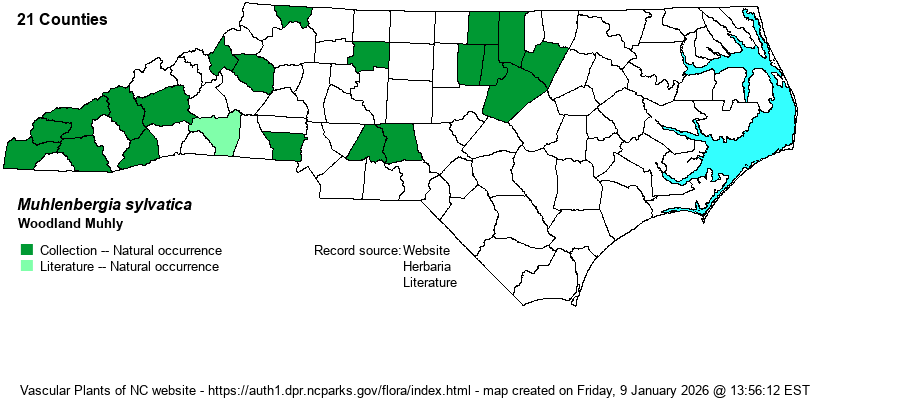| Author | Torrey ex A. Gray | |
| Distribution | Mountains and Piedmont; the apparent gaps will likely be filled with additional collecting.
ME to MN, south to SC and TX. | |
| Abundance | Uncommon to infrequent in the Mountains, and uncommon in the Piedmont. The NCNHP's State Rank of S1S2 is much too conservative; the website editors suggest S3, at it ranges across the Mountains and Piedmont. It is a Watch List species. | |
| Habitat | Bottomlands, streambanks, rock ledges along streams and rivers, moist rocky woodlands. Considering its wide array of wooded habitats, its scarcity is surprising, though this suggests that it may prefer high pH soils. | |
| Phenology | Flowering and fruiting July-October. | |
| Identification | This grass grows 1-2.5 feet tall, rarely to 3 feet, and with a long, slender inflorescence. The spikelets are generally appressed to the stalk. In overall gestalt, it most resembles M. tenuiflora, but differs in the longer lemma awn (5-18 mm long vs. a maximum of 12 mm long) and glumes as long or longer than the lemmas (vs. much shorter in M. tenuiflora). | |
| Taxonomic Comments | None
In NC the genus Muhlenbergia assumes 2 very different forms of inflorescences: very open and airy or narrow and elongate, with short branches. In both cases, attention to details of the key is important, along with a dissecting scope. Once learned, however, most muhlys can be identified on sight in the field. Spikelets contain a single floret (rarely 2-3). | |
| Other Common Name(s) | None | |
| State Rank | S1S2 [S3] | |
| Global Rank | G5 | |
| State Status | W7 [W1] | |
| US Status | | |
| USACE-agcp | FACW link |
| USACE-emp | FAC link |

